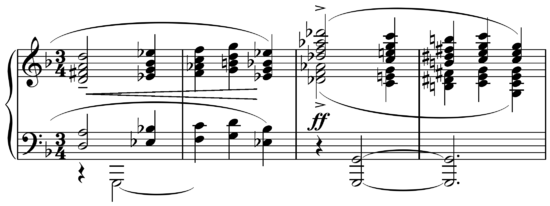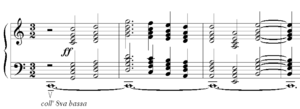
Harmonic parallelism
Encyclopedia

Music
Music is an art form whose medium is sound and silence. Its common elements are pitch , rhythm , dynamics, and the sonic qualities of timbre and texture...
, parallel harmony, also known as harmonic parallelism, harmonic planing or parallel voice leading, is the parallel movement of two or more lines (see voice leading
Voice leading
In musical composition, voice leading is the term used to refer to a decision-making consideration when arranging voices , namely, how each voice should move in advancing from each chord to the next.- Details :...
). Examples may be found in Claude Debussy
Claude Debussy
Claude-Achille Debussy was a French composer. Along with Maurice Ravel, he was one of the most prominent figures working within the field of impressionist music, though he himself intensely disliked the term when applied to his compositions...
's "Prélude à l'après-midi d'un faune" (1894), Maurice Ravel
Maurice Ravel
Joseph-Maurice Ravel was a French composer known especially for his melodies, orchestral and instrumental textures and effects...
's Daphnis and Chloë
Daphnis et Chloé
Daphnis et Chloé is a ballet with music by Maurice Ravel. Ravel described it as a "symphonie choréographique" . The scenario was adapted by Michel Fokine from an eponymous romance by the Greek writer Longus thought to date from around the 2nd century AD...
Suite No. 2 (1913), Richard Strauss
Richard Strauss
Richard Georg Strauss was a leading German composer of the late Romantic and early modern eras. He is known for his operas, which include Der Rosenkavalier and Salome; his Lieder, especially his Four Last Songs; and his tone poems and orchestral works, such as Death and Transfiguration, Till...
's Elektra
Elektra (opera)
Elektra is a one-act opera by Richard Strauss, to a German-language libretto by Hugo von Hofmannsthal, which he adapted from his 1903 drama Elektra. The opera was the first of many collaborations between Strauss and Hofmannsthal...
(1909), Arnold Schoenberg
Arnold Schoenberg
Arnold Schoenberg was an Austrian composer, associated with the expressionist movement in German poetry and art, and leader of the Second Viennese School...
's Pierrot Lunaire
Pierrot Lunaire
Dreimal sieben Gedichte aus Albert Girauds 'Pierrot lunaire' , commonly known simply as Pierrot Lunaire, Op. 21 , is a melodrama by Arnold Schoenberg...
, "Columbine" (1914), and William Schuman
William Schuman
William Howard Schuman was an American composer and music administrator.-Life:Born in Manhattan in New York City to Samuel and Rachel Schuman, Schuman was named after the twenty-seventh U.S. president, William Howard Taft, although his family preferred to call him Bill...
's Three Score Set for Piano (1944). In the last example the inversions
Inversion (music)
In music theory, the word inversion has several meanings. There are inverted chords, inverted melodies, inverted intervals, and inverted voices...
of the chords suggest a bichordal effect.


Lines with parallel harmony can be viewed as a series of chord
Chord (music)
A chord in music is any harmonic set of two–three or more notes that is heard as if sounding simultaneously. These need not actually be played together: arpeggios and broken chords may for many practical and theoretical purposes be understood as chords...
s with the same intervallic
Interval (music)
In music theory, an interval is a combination of two notes, or the ratio between their frequencies. Two-note combinations are also called dyads...
structure. Parallel means that each note within the chord rises or falls by the same interval.
In the example to the right, we see a series of quartal chords
Quartal and quintal harmony
In music, quartal harmony is the building of harmonic structures with a distinct preference for the intervals of the perfect fourth, the augmented fourth and the diminished fourth. Quintal harmony is harmonic structure preferring the perfect fifth, the augmented fifth and the diminished fifth...
in parallel motion, in which the intervallic relationship between each consecutive chord member, in this case a minor second
Semitone
A semitone, also called a half step or a half tone, is the smallest musical interval commonly used in Western tonal music, and it is considered the most dissonant when sounded harmonically....
, is consistent. Each note in the chord falls by one semitone in each step, from F, B, and E in the first chord to D, G, and C in the last.
See also
- Constant structureConstant structureIn jazz, a constant structure is a chord progression consisting of three or more chords of the same type or quality. Popularized by pianists Bill Evans and Herbie Hancock, the combination of functional and non-functional chords provides cohesiveness while producing a free and shifting tonal...
- Parallel keyParallel keyIn music, parallel keys are the major and minor scales that have the same tonic. A major and minor scale sharing the same tonic are said to be in a parallel relationship...
- Parallel chord
- Side-slippingSide-slippingIn jazz improvisation, to play outside, or out, is to intentionally stray from the key or chord changes of the song form. The term refers to a soloist taking some of the harmonic liberties of free jazz within a hard bop or modal context...
- Doubling (music)

